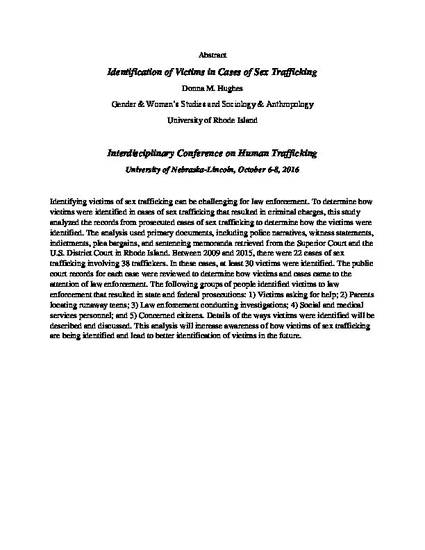
Presentation
Identification of Victims in Cases of Sex Trafficking - Abstract
Interdisciplinary Conference on Human Trafficking
(2016)
Abstract
Identifying victims of sex trafficking can be challenging for law enforcement. To determine how victims were identified in cases of sex trafficking that resulted in criminal charges, this study analyzed the records from prosecuted cases of sex trafficking to determine how the victims were identified. The analysis used primary documents, including police narratives, witness statements, indictments, plea bargains, and sentencing memoranda retrieved from the Superior Court and the U.S. District Court in Rhode Island. Between 2009 and 2015, there were 22 cases of sex trafficking involving 38 traffickers. In these cases, at least 30 victims were identified. The public court records for each case were reviewed to determine how victims and cases came to the attention of law enforcement. The following groups of people identified victims to law enforcement that resulted in state and federal prosecutions: 1) Victims asking for help; 2) Parents locating runaway teens; 3) Law enforcement conducting investigations; 4) Social and medical services personnel; and 5) Concerned citizens. Details of the ways victims were identified will be described and discussed. This analysis will increase awareness of how victims of sex trafficking are being identified and lead to better identification of victims in the future.
Keywords
- sex trafficking,
- prostitution,
- identification of victims,
- police,
- law enforcement
Disciplines
Publication Date
Fall October, 2016
Location
University of Nebraska-Lincoln
Citation Information
Donna M. Hughes. "Identification of Victims in Cases of Sex Trafficking - Abstract" Interdisciplinary Conference on Human Trafficking (2016) Available at: http://works.bepress.com/donna_hughes/51/
